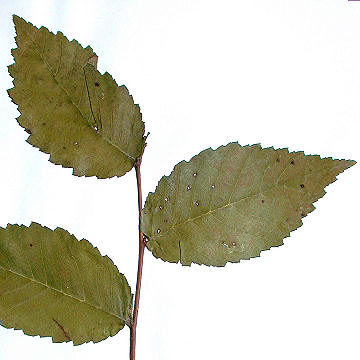

Ulmus rubra - (image 1 of 4)
Taxonomy
Family: Ulmaceae
Habitat
Moist woods and woodland borders.
Associates
Distribution
Southern ME and southern Quebec west to eastern ND, south to FL and TX.
Morphology
Deciduous tree with arching or ascending branches to 20 m. Bark laminated with all layers a similar shade of reddish-brown. Branchlets not corky-ridged; twigs scabrous-pubescent; mature buds blunt, usually not much longer than wide, densely covered in red-brown hairs in winter. Leaves alternate, 10-20 cm long, thick and stiff, very rough above, pinnately veined, strongly acuminate at the tip and asymmetrical as the base, doubly serrate, petioles abundantly pustular-hispid. Flowers perfect, in loose fascicles, subsessile on stout pedicels up to 5 mm long; calyx campanulate, oblique, lobed; stamens 5-9; stigmas pink. Fruit a flat, 1-seeded, suborbicular, slightly notched, 1.5-2 cm samara, pubescent only at the center, the sides glabrous and scarcely reticulate.
Notes
Flowers appearing before the leaves, from March to April
Wetland indicator: Facultative
Also called Red Elm. The inner bark is mucilaginous and has been used as a remedy for sore throat. Often inhabited by the Slippery Elm Midge (Dasyneura ulmea), which causes enlarged, blasted buds and immature leaf clusters. Similar to American Elm; most easily identified when in fruit.
References
Gleason, Henry A. and A. Cronquist. 1991. Manual of Vascular Plants of Northeastern United States and Adjacent Canada. Second Ed.
The New York Botanical Garden. Bronx, NY
Swink, F. and G. Wilhelm. 1994. Plants of the Chicago Region.
Indiana Academy of Science. The Morton Arboretum. Lisle, Illinois.
|
Michael Hough © 2009 |